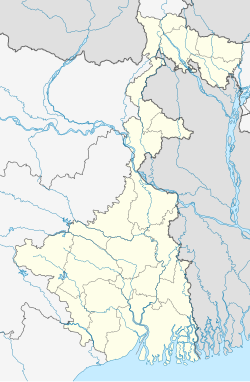Ajodhya Nagar is a census town in the Berhampore CD block in the Berhampore subdivision of the Murshidabad district in the state of West Bengal, India.
Ajodhya Nagar | |
|---|---|
Census Town | |
| Coordinates: 24°04′45″N 88°14′36″E / 24.079035°N 88.243445°E | |
| State | West Bengal |
| District | Murshidabad |
| Area | |
• Total | 1.5742 km2 (0.6078 sq mi) |
| Population (2011) | |
• Total | 8,883 |
| • Density | 5,600/km2 (15,000/sq mi) |
| Languages | |
| • Official | Bengali, English |
| Time zone | UTC+5:30 (IST) |
| PIN | 742102 |
| Telephone/STD code | 03482 |
| Vehicle registration | WB-57, WB-58 |
| Lok Sabha constituency | Baharampur |
| Vidhan Sabha constituency | Baharampur |
| Website | murshidbad |
Geography
edit5miles
River
River
River
River
M: municipal town, CT: census town, R: rural/ urban centre, H: historical centres
Owing to space constraints in the small map, the actual locations in a larger map may vary slightly
Location
editAjodhya Nagar is located at 24°04′45″N 88°14′36″E / 24.079035°N 88.243445°E.
Area overview
editThe area shown in the map alongside, covering Berhampore and Kandi subdivisions, is spread across both the natural physiographic regions of the district, Rarh and Bagri.[1][2] The headquarters of Murshidabad district, Berhampore, is in this area.[3] The ruins of Karnasubarna, the capital of Shashanka, the first important king of ancient Bengal who ruled in the 7th century, is located 9.6 kilometres (6.0 mi) south-west of Berhampore.[4][5][6] The entire area is overwhelmingly rural with over 80% of the population living in the rural areas.[7]
Note: The map alongside presents some of the notable locations in the subdivisions. All places marked in the map are linked in the larger full screen map.
Demographics
editAccording to the 2011 Census of India, Ajodhya Nagar had a total population of 8,883, of which 4,472 (50%) were males and 4,441 (50%) were females. Population in the age range 0–6 years was 891. The total number of literate persons in Ajodhya Nagar was 6,462 (80.86% of the population 6 years).[8]
Infrastructure
editAccording to the District Census Handbook, Murshidabad, 2011, Ajodhya Nagar (P) covered an area of 1.5742 km2. It had 7 km roads with open drains. The protected water-supply involved overhead tank, tube well/ bore well. It had 2,900 domestic electric connections, 20 road lighting points. Among the medical facilities it had 1 dispensary/ health centre, 1 nursing home. Among the educational facilities, it had 1 primary school in town, secondary, senior secondary schools, general degree college at Berhampore 0.5 km away. It had 1 recognised shorthand, typewriting & vocational training institute.[9]
Healthcare
editBerhampore CD block is one of the areas of Murshidabad district where ground water is affected by high level of arsenic contamination. The WHO guideline for arsenic in drinking water is 10 mg/ litre, and the Indian Standard value is 50 mg/ litre. The maximum concentration in Berhampore CD block is 635 mg/litre.[10]
References
edit- ^ "District Census Handbook: Murshidabad, Series 20 Part XII A" (PDF). Physiography, Page 13. Directorate of Census Operations, West Bengal, 2011. Retrieved 24 July 2017.
- ^ "Murshidabad". Geography. Murshidabad district authorities. Retrieved 24 July 2017.
- ^ "Murshidabad". Murshidabad district authorities. Retrieved 12 September 2017.
- ^ Ray, Nihar Ranjan, Bangalir Itihas Adi Parba, (in Bengali), 1980 edition, pp. 160-161, Paschim Banga Niraksharata Durikaran Samiti
- ^ Sengupta, Nitish, History of the Bengali-speaking People, p.25, UBS Publishers’ Distributors Pvt. Ltd.
- ^ Majumdar, Dr. R.C., History of Ancient Bengal, first published 1971, reprint 2005, pp. 5-6, Tulshi Prakashani, Kolkata, ISBN 81-89118-01-3.
- ^ "District Census Handbook, Murshidabad, Series 20, Part XII B" (PDF). District Primary Census Abstract page 26. Directorate of Census Operations West Bengal. Retrieved 2 July 2021.
- ^ "District Census Handbook, Murshidabad, Series 20, Part XII B" (PDF). Rural PCA-C.D. blocks wise Village Primary Census Abstract, location no. 315,449, page 39-39. Directorate of Census Operations West Bengal. Retrieved 2 July 2021.
- ^ "District Census Handbook Murshidabad, Census of India 2011, Series 20, Part XII A" (PDF). Section II Town Directory, Pages 981-987: Statement I: Growth History, Pages 990-993: Statement III: Civic & Other Amenities, Pages 993-995: Statement IV: Medical Facilities 2009, Pages 995-1001 Section V: Educational, Recreational and Cultural Facilities; Pages 1 001- 1002: Statement VI: Industry & Banking. Directorate of Census Operations, West Bengal. Retrieved 26 June 2021.
- ^ "Groundwater Arsenic contamination in West Bengal-India (20 years study )". Murshidabad. SOES. Archived from the original on 22 July 2011. Retrieved 4 August 2017.

